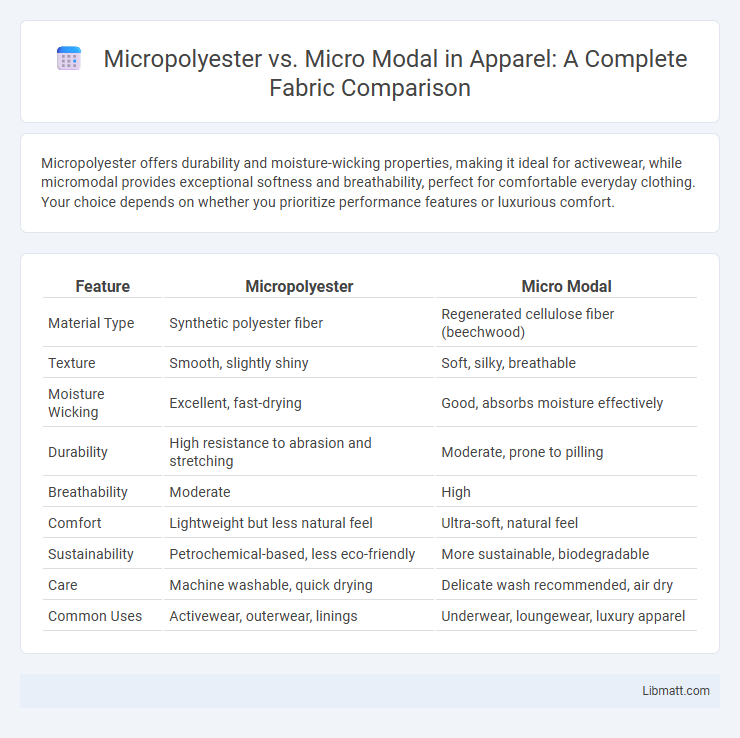Micropolyester offers durability and moisture-wicking properties, making it ideal for activewear, while micromodal provides exceptional softness and breathability, perfect for comfortable everyday clothing. Your choice depends on whether you prioritize performance features or luxurious comfort.
Table of Comparison
| Feature | Micropolyester | Micro Modal |
|---|---|---|
| Material Type | Synthetic polyester fiber | Regenerated cellulose fiber (beechwood) |
| Texture | Smooth, slightly shiny | Soft, silky, breathable |
| Moisture Wicking | Excellent, fast-drying | Good, absorbs moisture effectively |
| Durability | High resistance to abrasion and stretching | Moderate, prone to pilling |
| Breathability | Moderate | High |
| Comfort | Lightweight but less natural feel | Ultra-soft, natural feel |
| Sustainability | Petrochemical-based, less eco-friendly | More sustainable, biodegradable |
| Care | Machine washable, quick drying | Delicate wash recommended, air dry |
| Common Uses | Activewear, outerwear, linings | Underwear, loungewear, luxury apparel |
Introduction to Micropolyester and Micro Modal
Micropolyester is a synthetic fiber known for its durability, moisture-wicking properties, and resistance to wrinkles, making it ideal for activewear and performance clothing. Micro Modal, derived from beechwood pulp, is a semi-synthetic fabric prized for its exceptional softness, breathability, and eco-friendly production process. Your choice between these materials depends on whether you prioritize durability and moisture management or comfort and sustainability in your garments.
Composition and Manufacturing Processes
Micropolyester is a synthetic fiber derived from polyethylene terephthalate (PET) through melt spinning, creating ultra-fine filaments that enhance softness and durability. MicroModal, a type of rayon, is produced from beech tree cellulose through a chemical process involving dissolving pulp and reconstituting fibers, yielding a breathable and moisture-wicking fabric. The manufacturing of micropolyester emphasizes energy efficiency and recyclability, while MicroModal prioritizes eco-friendly sourcing and biodegradability.
Texture and Feel: A Sensory Comparison
Micropolyester offers a smooth, lightweight texture with a slightly silky feel, known for its moisture-wicking and quick-drying properties, making it ideal for athletic wear. Micro modal, derived from beechwood fibers, provides an exceptionally soft, breathable, and silky texture that feels luxurious and gentle against the skin. The tactile difference lies in micropolyester's synthetic resilience versus micro modal's natural, supple softness, influencing garment comfort and wearability.
Moisture-Wicking and Breathability
Micropolyester fibers excel in moisture-wicking due to their hydrophobic properties, rapidly drawing sweat away from the skin and promoting quick evaporation to keep the wearer dry. Micro modal, derived from beech tree cellulose, offers superior breathability with a soft, smooth texture that enhances air circulation and maintains comfort in warm conditions. Both materials optimize moisture management but micropolyester is generally more efficient in activewear applications, while micro modal suits casual, breathable garments.
Durability and Longevity
Micropolyester fabrics boast high durability due to their synthetic fiber structure, making them resistant to wear, shrinking, and stretching over time. Micro modal, derived from beech tree pulp, offers exceptional softness but tends to be less durable, with fibers more prone to pilling and degradation after repeated washes. When choosing your material for long-lasting garments, micropolyester provides superior longevity, while micro modal is better suited for delicate, luxury items where softness is the priority.
Sustainability and Environmental Impact
Micropolyester, derived from petrochemicals, poses significant environmental concerns due to its non-biodegradable nature and microplastic pollution during washing, contributing to ocean contamination. In contrast, micromodal is a semi-synthetic fabric made from sustainably sourced beech tree pulp, offering better biodegradability and a lower carbon footprint. Sustainable production of micromodal includes closed-loop processes that recycle solvents and minimize waste, making it a more eco-friendly choice in textile manufacturing.
Care and Maintenance Differences
Micropolyester is highly durable and resistant to shrinking, making it easy to care for with machine washing in cold water and tumble drying on low heat. Micro modal requires gentler handling, ideally washed in cold water on a delicate cycle and air-dried to prevent fabric weakening and maintain its softness. While micropolyester withstands frequent washing without significant wear, micro modal benefits from less aggressive care to preserve its luxury feel and extend garment lifespan.
Cost and Value for Money
Micropolyester typically offers lower production costs and greater affordability compared to micro modal, making it a budget-friendly option for consumers. Micro modal, derived from beechwood pulp, commands a higher price due to its superior softness, breathability, and eco-friendly properties, delivering better value for money in comfort and durability. Choosing between the two depends on prioritizing cost savings or investing in premium fabric performance and sustainability.
Best Uses and Popular Applications
Micropolyester excels in activewear and outdoor gear due to its moisture-wicking, quick-drying, and durable properties, making it ideal for gym clothes, sportswear, and rain jackets. Micro modal is favored in premium loungewear, underwear, and bedding because of its exceptional softness, breathability, and luxurious drape, offering enhanced comfort and moisture management. Both fabrics find use in fashion and home textiles but cater to distinct needs: performance and durability for micropolyester versus softness and comfort for micro modal.
Which Is Better: Micropolyester or Micro Modal?
Micropolyester offers superior durability, moisture-wicking properties, and resistance to wrinkles, making it ideal for activewear and outdoor clothing. Micro Modal excels in softness, breathability, and eco-friendly production, preferred for luxury loungewear and underwear. Choosing between micropolyester and micro modal depends on whether performance or comfort is the priority.
micropolyester vs micro modal Infographic

 libmatt.com
libmatt.com